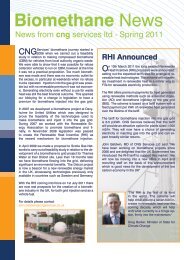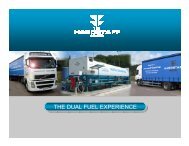Bio-SNG - CNG Services
Bio-SNG - CNG Services
Bio-SNG - CNG Services
Create successful ePaper yourself
Turn your PDF publications into a flip-book with our unique Google optimized e-Paper software.
BIO-<strong>SNG</strong> FEASIBILITY STUDY – ESTABLISHMENT OF A REGIONAL PROJECTThe status of CCS & the role of the UK Demonstration ProgrammeThe operation of the CCS chain has already been, and continues to be, demonstrated at 3Mte CO 2 /yr bythe Dakota Synfuels plant which has 10 years experience of operation of the full chain. The Synfuelsplant consists essentially of a syngas production unit which uses pre-combustion capture to produce adecarbonised hydrogen rich syngas which at Dakota is used in the manufacture of synthetic natural gas.In the power generation application, which is technically more straight-forward than synthetic natural gasproduction, decarbonised syngas is combusted in a Combined Cycle Gas Turbine to produce electricity –3Mte/yr of captured CO 2 equates to a power plant of ~500MWe underlining that there no scale issuesassociated with use of this capture technology and hence full scale commercial projects can beconstructed now 63,64 . However there are no clear reference plants for such Integrated GasificationCombined Cycle Power Stations with capture. This first-of-a-kind risk makes the attraction of debt intoearly projects challenging.There are examples of CO 2 storage in gas fields, oil fields and saline aquifers across the world, includingNorth Sea experience, although most injections are less than 1mte CO 2 /yr. This area has higheruncertainties than the capture element and requires demonstration at large scale in the North Seaenvironment for the different reservoir types available.Hence technology exists, and whilst there are clearly substantial uncertainties, the challenge is for themost developed options to move from the RD&D phase to early market applications. This is primarily anissue of putting in place the appropriate commercial framework to enable the first of a kind risks anduncertainties to be managed. Pre-combustion capture projects at say 400-800 MWe are possible now.The captured CO 2 can be stored, with the uncertainty being the scale of injection irrespective of reservoirtype. The UK has offshore oil fields, gas fields and saline aquifers which may be used for storage.Storage in oil fields holds the prospect of providing the greatest value added as CO 2 injection can beused to recover otherwise unrecoverable oil – this is an established technique on-shore with c25-30mteCO 2 injected annually in oil fields in the USA for this purpose. However offshore experience is minimal atpresent.The Programme therefore needs to address the real first-of-a-kind uncertainties in the early CCS projectseven where the technology exists, notably full CCS chain reliability and large scale storage. It needs to beon a basis which makes CCS a credible investment decision alongside renewables and gas CCGT.Investment capital is limited for all candidate investors – including the major utilities and so thedemonstration programme needs to be structured to enable debt to be secured, and such that the widestpossible range of investors can be involved, as has been achieved for renewables.63 In contrast other capture technologies suitable for power generation (post combustion and oxyfuel) have onlyoperated at small scale and do require substantial scale up.64 Pre-combustion capture can also be used to repower existing coal power stations to utilise cost effectively existing assetswith enhanced output compared with alternative refit options such as post-combustion.98









